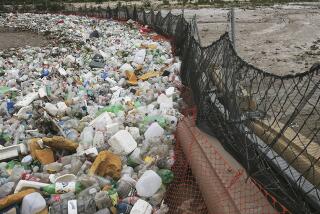ENVIRONMENT : As Boston Harbor gets cleaned up, ratepayers get cleaned out : After more than a decade, the $6.1-billion project is under way. But water and sewer bills have skyrocketed, as federal funds have dried up.
- Share via
BOSTON — As the long-awaited cleanup of Boston Harbor gets fully under way, alarms are being sounded about dramatic sewer rate increases resulting from the project.
The Massachusetts Water Resources Authority, which is undertaking the $6.1-billion project to improve treatment of sewage dumped in the harbor, estimates that the combined water and sewer rates, which have already risen 420% for average homes since the cleanup began in 1985, will more than double, to about $100 per month, by the end of the decade.
The Boston Harbor project first came to national attention during the 1988 presidential race, when Republican candidate George Bush blamed then-Massachusetts Gov. Michael S. Dukakis, the Democratic nominee, for delays in the cleanup and for making the harbor one of the nation’s dirtiest. Dukakis in turn blamed the delay on federal inaction and questions about cleanup technology.
Now the cleanup is taking place--and huge bills are coming in.
These expenses are creating a crisis for low-income families, about 100,000 of whom already cannot afford their water and sewer bills, the National Consumer Law Center reported.
“We have a major problem on our hands,” said Robert Ciolek, executive director of the Boston Water and Sewer Commission. He said water and sewer rate hikes in Boston, coupled with the recession, had already led to a tripling in the number of homes where the city has had to shut off water.
BACKGROUND: The cleanup is being carried out following a 1985 federal court order resulting from lawsuits against the district by the federal government and others over violation of the Clean Water Act. The district then was dumping 450 million gallons of poorly treated waste water and 50 tons of sludge daily on the outgoing tide, making the historic harbor one of the nation’s dirtiest.
During the 1970s, districts were eligible to receive federal grants of up to 75% to cover costs of mandated waste water treatment projects. But the grants were discontinued by 1987, with the federal government instead providing funds to start state loan programs for sewer districts.
Massachusetts established such a program in 1989, but the state, citing budget constraints, has failed to contribute to the fund.
The state Water Resources Authority has received only $73 million from the fund. That, along with $200 million in federal grants and an additional $100 million in federal funds promised earlier this year, is the only assistance the district has received so far, which leaves it with no choice, officials say, but to pass on the remaining costs to ratepayers.
Districts that will likely be hit hardest are those, such as Greater Boston, that are still building facilities to meet secondary, or advanced, waste water treatment standards set under the Clean Water Act. Officials around the country say the federal government has virtually abandoned support for sewer projects mandated under the 1972 Clean Water Act.
“It’s a national disgrace . . . that they’ve totally taken a walk” on federal funding, said Joseph E. Favaloro, executive director of the Water Resources Authority’s advisory board. The board represents authority communities, including Boston and its suburbs, 43 of which receive sewer service.
The 11-year Boston Harbor project includes the construction of a $1.3-billion waste water treatment plant on Deer Island, replacing two antiquated facilities. The new plant will provide both the primary waste treatment offered by the existing facilities and more intensive secondary treatment. Other elements: a sludge treatment plant, now complete, and a planned 9.5-mile outfall pipe to discharge treated sewage into Massachusetts Bay.
IMPACT: John J. Drew, an official with Action for Boston Community Development, an anti-poverty agency, expressed concern about the effect of the rate hikes on poor people, many of whom will now face rent increases. The action will force many into homelessness and others to double and triple up in apartments, he predicted.
Drew and other advocates say a program that directly assists the poor with their water and sewer bills, modeled after the federal fuel-assistance program, is needed. Favaloro, however, is calling for massive federal and state support.
Critics, including Bush, have said the water district is itself to blame for losing out on federal funding, since it sought a waiver from the Clean Water Act when federal funding was available. The waiver request was later dropped.
But Favaloro said the district--then run by another state agency--was advised by federal authorities at the time that the waiver was a viable option. And he said that as long as there is a federal mandate, there should be federal dollars available.
Other Cities’ Projects
Sewer rate inflation has gone national. The Assn. of Metropolitan Sewer Agencies has estimated that rates paid by consumers nationwide will double on average every six years for the foreseeable future as a result of continuing federal mandates and the lack of federal money to meet them. Among the cities hit hard:
* LOS ANGELES, where average sewer rates are expected to rise from $14 per month to $23 by 1996 as a result of a $3-billion project that includes completion of secondary treatment.
* SAN DIEGO, which is undertaking a $2.5-billion sewer project, much of it to provide secondary treatment. “Significant” sewer rate increases are expected over the next few years, officials said.
* SEATTLE, where average household sewer rates are expected to rise from the current $20 per month to $32 by 1997 as a result of a $1.2-billion project to complete secondary treatment.
* NEW YORK CITY, which may see rates rise 18% this year and the same amount next year. The money is needed to pay for a $1-billion project to comply with new federal mandates against ocean dumping of sludge, a byproduct of waste water treatment.
More to Read
Sign up for Essential California
The most important California stories and recommendations in your inbox every morning.
You may occasionally receive promotional content from the Los Angeles Times.










